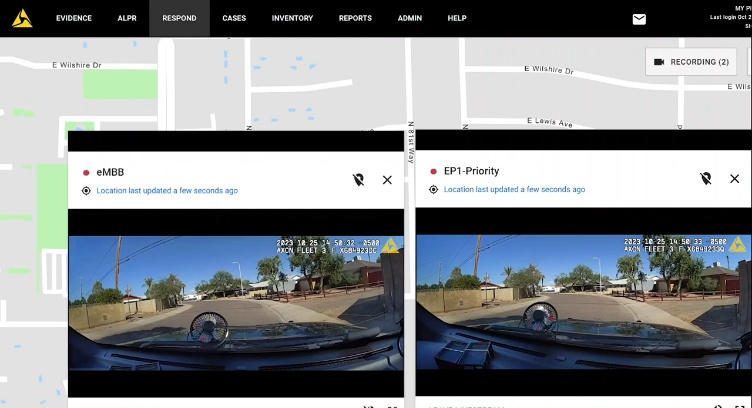Verizon recently demonstrated the ability to sustain performance levels for mission critical functions while passing video data over a network slice in a completely commercial 5G environment through Axon Fleet 3 and Axon Respond services.
Network slicing is a technology that allows customers to send data over virtual end-to-end networks tailored to specific application requirements, while also optimizing network performance to support all services. This capability, designed for network traffic on Verizon’s new cloud-native, containerized, virtualized standalone 5G core, will offer unprecedented levels of service agility, flexibility, and automated scalability.
In this demonstration on Verizon’s live 5G network in Phoenix, AZ, Axon ran side-by-side tests of its Axon Fleet 3 and Axon Respond solutions. The Axon Fleet 3 in-car video system provides live maps and live streaming from mobile cameras along with real-time situational awareness through Axon Respond to help enhance situational awareness for law enforcement members not on the scene.
In this demonstration, one video feed was run over a network slice on Verizon’s commercial 5G Ultra Wideband network and 5G Standalone core. The other test was run simultaneously over Verizon’s commercial 5G Ultra Wideband network without network slicing.
The test results were measured in four categories:
- The time to first frame, which is the time between when a remote law enforcement officer requests a stream and when that officer can remotely access the live stream.
- Start percent, or the percent of time the stream started before timing out and causing the law enforcement officer not on the scene to potentially abandon remotely accessing video and call into law enforcement personnel on the scene instead.
- Latency, or the responsiveness of the application across the network.
- Jitter, which is the sequence and timing of the audio and video packages being sent across the network.
The results showed the application, while running over a Verizon network slice, had sustained performance levels. Compared to Verizon’s commercial 5G Ultra Wideband network, services on the network slice showed:
- 53% improvement in 95th percentile of time to first frame
- 5% improvement in start percent
- 68% improvement in latency
- 83% improvement in jitter
Axon Senior Director of Product Management Blake Bullock
When engaging in a public safety incident, accurate and timely live streaming and location information is mission critical for enhancing law enforcement’s situational awareness and its ability to make decisions based on real-time, accurate information. Our work with Verizon’s 5G lower latency network slice improved streaming rate success and accelerated time to first frame for our Axon Fleet 3 Respond services under both network congestion and cell edge conditions.
Adam Koeppe, SVP of Network and Technology Planning for Verizon
This most recent network slicing demonstration shows one of many use cases where network slicing can be a game-changer for our enterprise, public sector, and Verizon Frontline customers. We have undergone a massive transformation of our network over the past few years, including building on a cloud-native architecture, virtualizing from the core to the edge, building an advanced 5G standalone core, driving capacity in our fiber core, adding robust and varied spectrum assets, and infusing intelligence throughout the network. These changes allow us to develop and test this new technology that effectively matches the required network resources with the performance characteristics needed for an app or use case to work effectively.




















